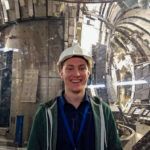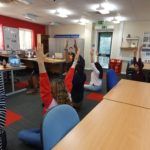Profile
Robert Kerr
-
About Me
Hi! I'm Rob and when I'm not researching radioactive material I'm usually watching films or listening to music. I love going to the cinema and seeing my favourite artists at gigs or festivals. I also like playing racket sports such as tennis/badminton and I sing tenor in a choir at Oxford.
-
Read more
To be totally honest with you, I don’t feel like much of an engineer!
I studied Chemical Physics at the University of Bristol because my favourite subjects at school were chemistry, physics and maths and I wanted to carry on with all them. This turned out to be absolutely the best decision and I got to learn about my favourite parts of both chemistry and physics.
So why am I called an engineer? My field of research is a combination of engineering, chemistry and physics called materials science and I look at materials that are used in nuclear fusion.
I first heard about fusion during a physics lesson in school and was immediately interested in learning more about how it could be used as a clean, sustainable source of energy. When I found out that there were actual experimental fusion reactors in the UK, I booked to go on a tour to see them. I visited the Culham Centre for Fusion Energy (CCFE) on an open day when I was in college then later was lucky enough to work at CCFE for 12 months in 2017/18.
During my time at Culham my supervisor really encouraged me to pursue graduate research and this is also where I heard about the Fusion CDT, the doctoral training programme that I’m part of now. I applied for PhDs in fusion materials as a way of incorporating the knowledge I gained from my undergraduate degree into my interest in fusion, all while doing something hands on that could really make a difference.
-
My pronouns are
he/him
-
My Work
I work on the international fusion project known as JET, looking at high temperature radiation damage in first wall armour materials and how this affects mechanical properties.
-
Read more
My PhD project is focused on samples from the JET fusion reactor that have been exposed to temperatures of up to 3500°C and have interacted with fusion products and fuel ions.
The reactor’s exhaust system, called the divertor, sits at the bottom of the machine and removes impurity ions from hindering the fusion reaction. The divertor is primarily made from tungsten because of it’s large atomic number, high melting point (3422 °C) and density which makes it very resistant to erosion. The main chamber wall is made out of beryllium because it has good thermal shock properties and beryllium impurities are not overly disruptive to the fusion reaction.
After exposure in the reactor these materials can melt, become brittle and flake off. We want to know:-
- Which samples have melted or cracked and what conditions may be the cause
- How the mechanical and thermal properties have changed and why
- What are the potential mechanisms of failure and their effect on material lifetimes
I’m trying to answer these questions using techniques such as nanoindentation, scanning electron microscopy (SEM) and transmission electron microscopy (TEM). Nanoindentation presses a diamond tip into the sample surface and records a stress-strain curve which can be used to find the Young’s modulus and hardness within localised areas of the material. SEM and TEM use beams or electrons to view the sample, unlike a benchtop optical microscope which uses a beam of light. The electron beam in an SEM can be used to view a conductive sample by exciting the surface and releasing secondary electrons which are collected and used to create an image. In TEM the sample has to be extremely thin to let the electron beam pass through it, the beam that emerges on the other side forms a diffraction pattern that is used to reconstruct an image with sub-nanometer resolution.
-
My Typical Day: After some porridge or a slice of toast I'm usually running to get the train to my lab at Culham, called the Materials Research Facility. My samples are stored here and can only be handled by the facility technicians because they are classified as low-level radioactive. Once a sample has been loaded into a scientific instrument I usually spend the rest of the working day using the microscope or nanoindenter. I then get the train home, make dinner with my housemates and do something outside of work like reading or doing some exercise.
-
What I'd do with the money
I'm part of the Science Together public engagement project where researchers from across Oxford's various institutions collaborate and try to tackle some issues that have been brought to us by local community groups. The money would be put straight into this project and would help get our ideas off the ground.
-
Read more
There’s a lot of great work being done by the Science Together project including: science clubs for students affected by COVID, improving disability access in the city and preventing bike theft.
-
Education:
St George’s College, Weybridge (2010-2015); University of Bristol (2015-2019); University of Oxford (2019-present)
-
Qualifications:
12 GCSEs; 4 A Levels; MSci Chemical Physics
-
Work History:
Tutoring Maths and Chemistry GCSE & A Level; 12 month Placement at CCFE
-
Current Job:
PhD Student
-
Employer:

-
My Interview
-
How would you describe yourself in 3 words?
friendly fusion enthusiast
What's the best thing you've done in your career?
My year in industry - I'm such a big advocate and would really recommend it to students
What or who inspired you to follow your career?
In addition to great teachers and mentors (shout-out to my industry supervisor Dr Debasmita Samaddar!), a big driving force for my career is the goal of fusion - to deliver a sustainable and reliable energy source that produces no greenhouse gases or long-lived radioactive isotopes.
What was your favourite subject at school?
Maths
What did you want to be after you left school?
I knew I wanted to do something in science but didn't know what
Were you ever in trouble at school?
Not really, I was mostly just a bit quiet
If you weren't doing this job, what would you choose instead?
A job in the Civil Service
Who is your favourite singer or band?
Wolf Alice (current) or Fleetwood Mac (all time)
What's your favourite food?
Sushi
What is the most fun thing you've done?
Going to Glastonbury - It's so much fun and I will always try to get tickets
If you had 3 wishes for yourself what would they be? - be honest!
To be better at remembering things, to have a bit more faith in myself and to be able to go to bed early!
Tell us a joke.
My "career"
-



